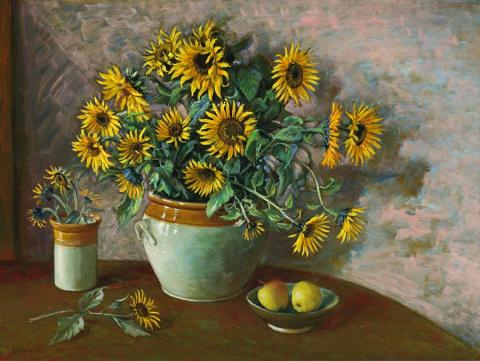SUNFLOWERS, c.1972
MARGARET OLLEY
oil on composition board
91.0 x 121.0 cm
signed lower left: Olley
Private collection, Brisbane
Private collection, Queensland
Celebrating the domestic treasures of her immediate world, Margaret Olley's paintings are beloved examples of the still-life genre. As observed by the artist's lifelong friend Edmund Capon, 'Still-lifes and interiors are her métier, and Margaret Olley is a part of that tradition, from Vermeer in the seventeenth century to Morandi in the twentieth century - two of her most admired artists - which finds inspiration, beauty and a rich spirit of humanity in the most familiar of subject matter.'1
Elegantly framed with a precise eye for the rhythm of objects and space, fundamental to Olley's still-life and interior scenes is the principle of orchestration. Her considered arrangements of vessels, flowers and fruit owe much to her experience of the theatre in 1948 when Olley assisted with painting the sets for Sam Hughes's productions of Shakespeare's Pericles and Cocteau's Orphee (designed by Jean Bellette and Sidney Nolan respectively). Observing the actors being instructed to enter the stage and count twenty seconds before speaking their lines, the young artist soon came to appreciate the importance of creating space for oneself; as she fondly recalls, 'space is the secret of life... it is everything.'2 Over the ensuing decades, Olley began to arrange the objects in her art as characters on a stage - objects both commonplace and beautiful, shuffled this way and that, plunged into deep shadow or transformed by lighting.
A tour-de-force of scale and subject, Sunflowers undoubtedly pays homage to Vincent Van Gogh, an artist much admired by Olley. Like Van Gogh, Olley has arranged the joyfully casual blooms in slip-glazed earthenware, no doubt a careful selection from the artist's substantial collection of ceramic vessels. Combined, the composition serves to create anintimate, uplifting drama for the eye and mind to explore. Paying homage to the domestic surroundings which continue to provide her inspiration, indeed the work reveals the very essence of the artist's identity; as Barry Pearce aptly notes,'... to live with a Margaret Olley painting is to experience the transfiguration of a passionate, highly focused personality into art. In her paintings, the space surrounding each bowl of fruit, each vase of flowers, and through which the eye traverses a cacophony of surfaces such as patterned carpets, modulated walls and cluttered tabletops, resounds with her presence. These are reflections of the things she loves, and which embellish the centre of how she prefers her existence to be.'3
1. Capon, E., as quoted in Pearce, B., Margaret Olley, The Art Gallery of New South Wales, Sydney, 1996, p. 7.b
2. Margaret Olley, cited in Pearce, B., op. cit., p. 14
3. Pearce, B., 'Margaret Olley Retrospective', State of the Arts, Sydney, August - November 1996, p. 5
MERRYN SCHRIEVER
